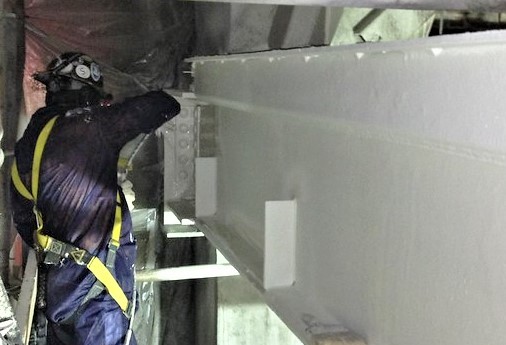Fire retardant

|
| Workers apply intumescent paint to a floor beam at the 44th Street facility. Source: MTA Construction & Development Mega Projects. |
Contents |
[edit] Introduction
A fire retardant is a substance such as a coating, powder, foam, gel or spray, that is used to slow - and eventually stop - the spread of fire. It is a preventive measure that can help limit a fire’s spread by triggering a chemical reaction.
[edit] History
The earliest form of fire retardants (which were thought to have originated many centuries ago) were substances such as vinegar, alum and clay that were used to treat timber and some fabrics.
More complex fire retardants were introduced in the 19th century in the form of flame retardants for fabrics. These were developed by Joseph Louis Gay-Lussac, a French chemist who made a number of discoveries in the idea of temperature and its relationship to gas pressure (Gay-Lussac’s Law or Amontons's law).
His exploration of the use of salts as fire retardants was groundbreaking, but it wasn’t until the 1900s that more effective measures would be introduced in the form of flame retardants.
[edit] Fire retardant or flame retardant?
Modern fire retardants and flame retardants have similar purposes - to control fires - but they achieve this by different methods:
- Flame retardants are chemicals (such as aluminium hydroxide) usually applied to combustible materials (such as textiles, plastics and coatings).
- Fire retardants are chemicals (for example, ammonium and diammonium sulfate) that can also be used on surfaces, but different types of chemicals are used for different purposes. Fire retardants as extinguishers include chemicals that will absorb a great deal of heat to cool whatever has been treated. Other agents will react with the heat to put out the fire by releasing water vapour or carbon dioxide. This is a physical process called dilution. Other fire retardants are intumescent coatings (such as paints or plastic additives). These rely on substances that will expand through a chemical reaction when heated to protect the materials that have been coated. For more information see: Intumescent coatings.
NB Fire retardants can also be dropped from planes to extinguish forest fires.
[edit] Related articles on Designing Buildings Wiki
Featured articles and news
The history of building regulations
A story of belated action in response to crisis.
Moisture, fire safety and emerging trends in living walls
How wet is your wall?
Current policy explained and newly published consultation by the UK and Welsh Governments.
British architecture 1919–39. Book review.
Conservation of listed prefabs in Moseley.
Energy industry calls for urgent reform.
Heritage staff wellbeing at work survey.
A five minute introduction.
50th Golden anniversary ECA Edmundson apprentice award
Showcasing the very best electrotechnical and engineering services for half a century.
Welsh government consults on HRBs and reg changes
Seeking feedback on a new regulatory regime and a broad range of issues.
CIOB Client Guide (2nd edition) March 2025
Free download covering statutory dutyholder roles under the Building Safety Act and much more.
AI and automation in 3D modelling and spatial design
Can almost half of design development tasks be automated?
Minister quizzed, as responsibility transfers to MHCLG and BSR publishes new building control guidance.
UK environmental regulations reform 2025
Amid wider new approaches to ensure regulators and regulation support growth.
The maintenance challenge of tenements.
BSRIA Statutory Compliance Inspection Checklist
BG80/2025 now significantly updated to include requirements related to important changes in legislation.






















